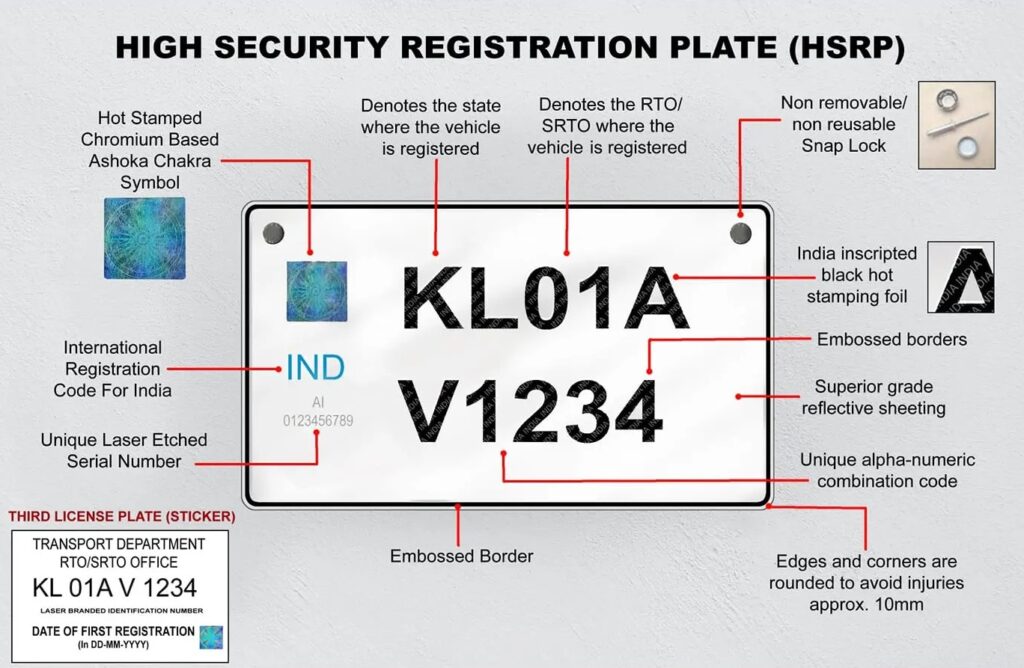High Security Registration Plates (HSRP) are specially designed vehicle number plates introduced by the Government of India to prevent theft, fraud, and tampering of vehicle identities. These plates feature tamper‐proof locks, laser‐etched unique codes, chromium holograms, and reflective sheeting to enhance visibility and authenticity. Mandated under Rule 50 of the Central Motor Vehicles Rules, 1989 and enforced by various state transport authorities, HSRPs are now compulsory for all new and pre‑2019 vehicles, with deadlines and penalties varying by state. This guide breaks down what HSRPs are, why they’re mandatory, who must comply, costs involved, step‑by‑step application processes, key benefits, state‑wise procedures, and how to track or replace your plate – all in simple, reader‑friendly language.

What Are High Security Registration Plate (HSRP)?
HSRPs are official vehicle number plates made from durable aluminum, fitted with two non‑reusable snap‑on locks to stop tampering and theft.
Each plate carries a laser‑etched 10‑digit Permanent Identification Number (PIN) linked to a central government database, ensuring every vehicle’s identity is unique and verifiable.
A chromium‐based hologram of the Ashoka Chakra is hot‑stamped on the top left corner to prevent counterfeiting.
The plate also uses reflective sheeting under the alphanumeric characters to improve visibility at night, aiding traffic enforcement and safety.
Why Are HSRPs Mandatory?
Under Rule 50 of the Central Motor Vehicles Rules, 1989, the Ministry of Road Transport & Highways (MoRTH) mandated HSRPs for all new vehicles registered from April 1, 2019, and required older vehicles to retrofit by specified deadlines.
This move aims to curb vehicle‐related crimes like cloning, illegal resale, and identity fraud by making it technologically harder to forge plates.
Standardizing plates across India also helps law enforcement swiftly verify vehicle details through Automated Number Plate Recognition (ANPR) systems.
States enforce different deadlines and penalties – for instance, Pune’s RTO set a June 30, 2025 deadline, warning non‑compliant owners of fines and legal action.
Who Needs an High Security Registration Plate (HSRP)?
- New Vehicles (Post‑April 1, 2019): Already factory‑fitted with HSRPs and compliant by default.
- Older Vehicles (Pre‑April 1, 2019): Must retrofit to HSRPs before their state’s deadline to avoid penalties.
In cities like Nagpur, only 10.3% of pre‑2019 vehicles had installed HSRPs as of early May 2025, highlighting the need for owner awareness and timely compliance.

Cost & Charges
High Security Registration Plate (HSRP) prices vary by vehicle type and state regulations. On average:
- Two‑Wheelers: ₹400 (plate) + ₹100 (colour‑coded sticker).
- Four‑Wheelers: ₹700–₹1,100 (plate) + ₹100 (sticker).
Note that state transport departments may levy additional fees or taxes; always verify current rates on the official RTO or MoRTH portal.
How to Apply for Your HSRP Online
- Visit the Official Portal: Go to your state’s authorized site—e.g., BookMyHSRP (bookmyhsrp.com) for many states, or Karnataka’s transport.karnataka.gov.in.
- Enter Vehicle Details: Provide your registration number, chassis and engine numbers, and complete the CAPTCHA.
- Choose Fitment Location & Slot: Select a convenient installation centre and appointment date.
- Make Payment: Pay the applicable fee online; keep the transaction receipt or download the e‑slip.
- Get Your Plate Installed: Visit the chosen centre on your appointment day for fitting with tamper‑proof locks.
Key Benefits of HSRP Installation
1. Theft Deterrence
Advanced security features make plates nearly impossible to remove or clone, discouraging vehicle theft.
2. Quick Authenticity Checks
Law enforcement can instantly verify a vehicle’s details via the unique PIN and hologram, reducing fraud.
3. Improved Road Safety
Reflective plates aid visibility at night, and ANPR systems can track violators, helping manage traffic efficiently.
4. Hassle‑Free Tracking
Laser‑etched codes are readable by high‑speed cameras, simplifying vehicle tracking during violations or emergencies.
State‑Wise Application Notes
- Karnataka: Deadline extended to May 31, 2025; High Court relief on fines until June 12, 2025 (subject to change).
- Maharashtra: Standard rates set at ₹450–₹745 (excluding GST); compliance remains low in Pune and Nagpur.
- Telangana & Delhi: Fully online process via state portals; penalties up to ₹5,500 in Delhi for non‑compliance.
Colour‑Coded Stickers Explained
A mandatory sticker on the vehicle’s windscreen indicates fuel type and emission norms:
- Blue: Petrol & CNG vehicles.
- Orange: Diesel vehicles.
- Green: Electric vehicles.
Each sticker also bears a laser‑etched code for additional tracking and authenticity checks.
Tracking & Duplicate HSRP
- Track Status: Use the “Track Your Order” feature on BookMyHSRP or your state portal with order number and vehicle details.
- Duplicate Plate: In case of loss/damage, select “Replacement Booking,” enter vehicle/chassis/engine details, pay the duplicate fee, and book a fitment slot.
Conclusion
By understanding these key aspects – what HSRPs are, why they’re mandatory, how much they cost, and how to get them – you can ensure your vehicle stays compliant, secure, and road‑legal. Don’t wait for deadlines or penalties to knock on your door; book your High Security Registration Plate today!


